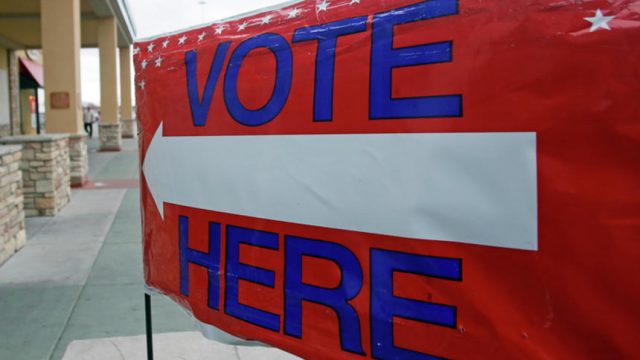North Dakota Republicans Nearly Double Democrats in Strong Midterm Year Primary Turnout

People stop at West Acres in south Fargo, N.D. to vote on Tuesday, November 04, 2014. Carrie Snyder / The Forum
Voter turnout for last night’s primary election was surprisingly strong statewide despite a lack of competitive races on the statewide ballot, or even a single ballot measure. And the fact that this is a midterm election year and turnout is typically down anyway.
As of this morning there were over 114,000 ballots cast, good for a turnout percentage of 19.66 percent. Here’s how that stacks up historically:
For all the legal wrangling and political pie-throwing we’ve seen over North Dakota’s voter ID laws, they seem to have done very little to change overall turnout. “It’s good to know voter ID issues are seemingly nonexistent at the polls,” Jennifer Cook, a local ACLU lawyer, was quoted as saying.
Maybe the griping about voter suppression from people like Senator Heidi Heitkamp is just political posturing intended to inflame a political base?
Remember that in North Dakota, during the June vote, North Dakotans are choosing the nominees for each party in the various races. This is a little confusing because the parties also endorse candidates at their statewide conventions in the spring, but those endorsements are just that. Endorsements. The actual candidates were chosen last night, and there were no surprises.
What is interesting to look at, from an overall perspective, is the turnout each party enjoyed for their races. Republicans enjoyed a clear advantage over Democrats in terms of turnout, enjoying about 1.9 votes for every Democratic ballot cast, though that’s way down from the 2016 cycle when Republicans enjoyed a historically high ratio (probably due to Democratic voters crossing over to cast ballots in the contested gubernatorial primary between Doug Burgum and Attorney General Wayne Stenehjem):
To get those ratios I averaged the number of ballots cast in each partisan, statewide race for each of the two parties and then compared those numbers to one another.
Democrats got some of their primary voters back in 2018, but the trend line for the number of ballots cast for each party should be troubling for our liberal friends. Again, these numbers represent an average turnout in each partisan, statewide race on the ballot:
The trend, for nearly the last two decades worth of election cycles, is for Democrats to lose primary voters while Republicans gain them.
I write and talk a lot about how Democratic candidates in North Dakota start sounding a lot like Republicans in election years. Democrats have even, amazingly, begun aligning themselves with President Donald Trump this election cycle in a cynical attempt to put their top candidate, Senator Heidi Heitkamp, over the top.
You have to wonder if that’s a tactic with diminishing returns for them, long term. As they lose votes from their base Democrats find themselves needing to go further right to peel off votes from Republicans. But then that probably further demoralizes their liberal base.
It’s a vicious cycle.







